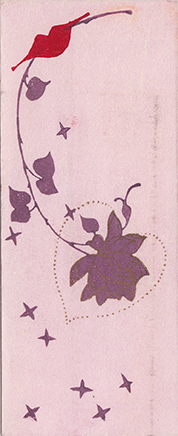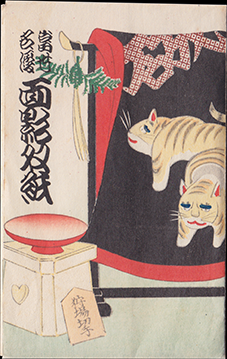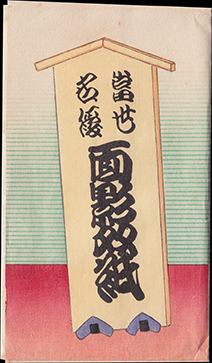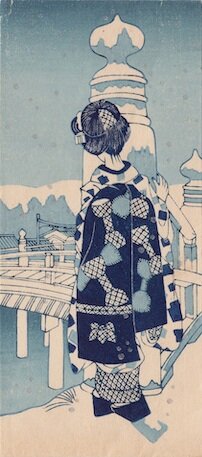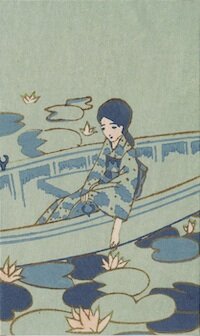Gallery 7: Pochibukuro (Money Envelopes)
Unidentified Artist. Actor in the Kabuki Play Shibaraku. 1920-1930s. 4.2 x 9.0 cm
Pochibukuro are small envelopes for gifts of money. These were presented to children on New Year and to adults on celebratory occasions. Although the artist is often not identified, several well known Meiji period and shin-hanga artists created designs for these ephemera. Themes included many of the same topics characteristic of woodblock prints including landscapes, kabuki, and portraits of women. As can be seen in the images below, a popular theme was the portrayal of a Maiko from behind highlighting her high fashion kimono. Pochibukuro were often produced with high printing standards which might include the use of metalic pigments. This gallery features pochibukuro that were mostly created between 1910 and 1940.
Hasegawa Sadanobu III (1881-1963)
The four pochibukuro below are from a set depicting the play Kanjincho (The Subscription List).The actors and year of performance have yet to be determined.
The six pochibukuro below are from the series Kumadori Soroi. Each envelope depicts the Kumadori of a role from a kabuki drama. The date of publication has not been determined for this set.
Izutsu Okamoto (fl. ca. 1920s-1930s)
The following pochibukuro by Izutsu Okamoto is unique in that panels can be opened to reveal an additional component to the scene that is printed on an enclosed folded sheet of writing paper.
Enomoto Chikatoshi (1898-1973)
Hirai Fusato
Ito Toshio
Ito Shisui (1898-1972)
Kasamatsu Shirō (1898-1991)
Pagoda of Nikkō Tōshō-gū. 1930s. Published by Watanabe Hangaten. 6.2 x 15.7 cm
From the set Souvenir of Kamakura (Kamakura Miyage) Published by Watanabe Hangaten, most likely in the 1930s. 6.2 x 15.6 cm
Underground Prison at Daitō Shrine. From the set Souvenir of Kamakura (Kamakura Miyage) Published by Watanabe Hangaten, most likely in the 1930s..6.3 x 15.7 cm
The Kamakura Great Buddha. From the set Souvenir of Kamakura (Kamakura Miyage) Published by Watanabe Hangaten, most likely in the 1930s. 6.2 x 15.7 cm
Drum Bridge (at Tsurugaoka Hachiman Shrine). From the set Souvenir of Kamakura (Kamakura Miyage) Published by Watanabe Hangaten, most likely in the 1930s. 6.2 x 15.6 cm
Wooden Lantern at Tsurugaoka Hachimangū Shrine. From the set Souvenir of Kamakura (Kamakura Miyage) Published by Watanabe Hangaten, most likely in the 1930s. 6.2 x 15.8 cm
Chigokafuchi. From the set Souvenir from Enoshima. Published by Watanabe Hangaten, 6.2 x 15.7 cm
Enoshima Bridge (Enoshima sanbashi). From the set Souvenir from Enoshima. Published by Watanabe Hangaten. 16.2 x 15.8 cm
Enoshima Iwaya Cave (Enoshima iwaya). From the set Souvenir from Enoshima. Published by Watanabe Hangaten. 6.2 x 15.7 cm
Enoshima After Snowfall.(Enoshima setsugo). From the set Souvenir from Enoshima. Published by Watanabe Hangaten. 6.3 x 15.7 cm
Shichirigahama. From the set Souvenir from Enoshima. Published by Watanabe Hangaten. 6.1 x 15.7 cm
Enoshima Okutsu Shrine (Enoshima okutsu miya). From the set Souvenir from Enoshima. Published by Watanabe Hangaten. 6.2 x 15.5 cm
Kobayashi Kaichi (1896-1968)
Published by Sakuraiya, Kyoto in the 1910s-1930s.
(Attributed). 6.4 x 15.4 cm
The following nine pochibukuro and box cover are from the set Gion Atmosphere.
The four pochibukuro below form a quadriptych image when viewed together.
Kamishita Chikamine (Kamishita Shuho)
The following are from sets of pochibukuro by Kamishita Chikamine (Kamishita Shuho) from the series Images of Famous Actors of Today published by Masukawa Yasukichi. Each set featured portraits of four actors from specific kabuki performances staged in the 1920s. The polchibukuro are assumed to have been printed close to the dates of the performances.
The two images below were acquired without the associated envelope or the accompanying additional two protraits.
The following are three sets of pochibukuro from the series Stage Picture Scroll. The first collection was errantly enclosed in the envelope for another set and is included here without the corresponding envelope.
Ochiai Mansui
New year theme - Hagoita; shimenawa (sacred rope); and kagami mochi. 1920s-1930s 4.3 x 9.2 cm (see back)
Reinosuke
Takahashi Haruka (Dates Unknown)
Takehisa Yumeji (1884-1934)
Tanaka Shikō
Nakamura Kichiemon I as Mitsuhide. 1920s. 5.5 x 9.0 cm
Tekiho Nishizawa (1889-1965)
Yamakawa Shūhō (1898-1944)
Works by yet to be identified artists.
Unidentified artist
Fisherwoman.c.1940. 4.3 x 9.1 cm
Unidentified artist
Moon and Pampas Grass. 1920s-1930s. 4.2 x 7.2 cm
Unidentified Artist
Kumadori and Wig for Yanone. 4.1 x 9.3 cm
Unidentified artist
Five-Story Pagoda at Toji Temple. From the set Outstanding Sites of Kyoto. Published by Sakuraiya. c.1920s-1930s.11.9 x 7.2 cm
Similar to another pochibukuro in the collection by Izutsu Okamoto, the following envelope depicting Yasaka Shrine by an unidentified artist includes panels that reveal an additional component to the image when opened. The additional image is printed on folded writing paper enclosed within the pochibukuro.
Envelope for Gion Festival Pochibukuro 9.2 x 19.7 cm
A set of six envelopes representing the Gion festival in Kyoto by an unidentified artist. Each envelope is part of a large horizontal image. Published by Sakuraiya. Envelopes are approximately 7.2 x 16.0 cm in size.
These four pochibukuro are from the set Kabuki New 32 Favorite Plays which was published for Matsuzakaya department store in the 1930s or earlier. These depict kabuki actors on hagoita, wooden paddles used to hit shuttlecocks.
A set of pochibukuro depicting Noh scenes by an unidentified artist.
A set of pochibukuro depicting images of early ukiyo-e masters. Late 1920s- early 1930s.
The following set is composed of five envelopes, each which is part of a larger scene when put together. Comparing the poses to other envelopes in the collection suggests that several others may also have originally been part of a larger scene. Each envelope is about 5.5 x 15.5 cm.
Unidentified Artist. A set of seven pochibukuro titled Famous Places. The set was printed in the Japanese city of Haibara.
Unidentified artist. A set of five very small pochibukuro from a series titled Goshinto. Pre-war.
Unidentified Artist. Set of five pochibukuro with a title referencing dance. Pre-war.
A set of six pochibukuro depicting ema (“picture horses”) representing signs of the zodiac. Another set was likely published to provied the other six zodiac animals. The series name Fushima Ema may refer to either the area or the shrine named Fushima.
The following series of pochibukuro depicts images adapted from the series The Storehouse of Loyal Retainers (Chûshingura) by Ando (Utagawa) Hiroshige (1797-1858). The original sixteen Hiroshige prints were published in the horizontal oban format by Izumiya Ichibei between 1835 and 1839. Each of the images on the pochibukuro reproduce a small section from each of the original sixteen prints with the exception of the print for Act XI, The Night Attack, Part 4. This pochibukuro set was published pre-WWII. The prints shown below are a composite of 14 pochibukuro first acquired for the collection combined with the missing pochibukuro for Act X and the box and packaging envelopes that were later acquired as part of a complete set.
Wooden Box for the set.
This set is titled Famous Places of the Eastern Capital. Although some images have similarities to works by Ando Hiroshige, none are failthful reproductions of that artist’s works and some do not appear to have been inspired by any of the many series he produced with this theme.
A set of 10 very small pochibukuro titled Portraits of Famous Actors from Kabuki by an unknown artist. Pre-war.
Onoe Usaburô II as Ushi Gorô in the play Bushi to Mago. 3.4 x 5.2cm
A set of 12 small pochibukuro featuring Kabuki actors by an unknown artist. Pre-WWII.
Below are images adapted from an 1892 print series of biographies and portraits of kabuki actors Ichikawa Danjūrō I to IX by Utagawa Yoshiiku. These envelopes depict the actors in roles that they they made famous in the Jūhachiban (eighteen best kabuki plays). In contrast to the other portraits, the depiction of Ichikawa Danjuro I is in the Torii syle. Six of the images (Ichikawa Danjuro I, II, III, IV; V, and VII) are also represented on an uncut sheet of pochibukuro in the collection from the 1910s-1920s which can be viewed in Gallery 1.
This following six larger pochibukuro appear to have been created for either the Taishō or Shōwa Imperial Investiture Ceremonies (1917 or 1928).
A set of Pochibukuro by an unidentified artist depicting Kabuki actors. Originally printed around 1920 to 1940, this is a later edition after 2000.
Unidentified artist. Six Pochibukuro from the third set of a three-part series devoted to Juhachiban (The Eighteen), the eighteen plays of Danjiro. Undated.
A Set Depicting the Crests (Mon) of Kabuki Actors and Characters.






















































































































